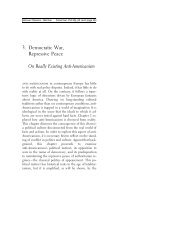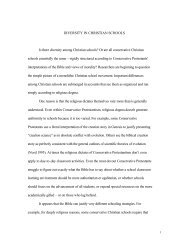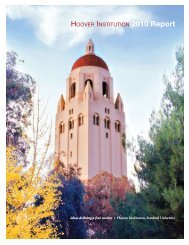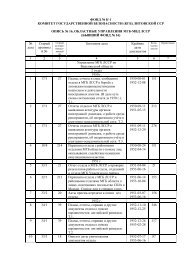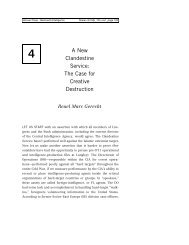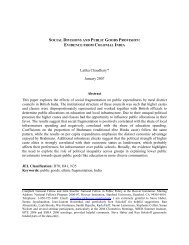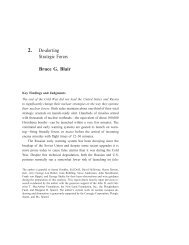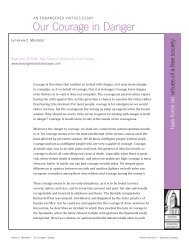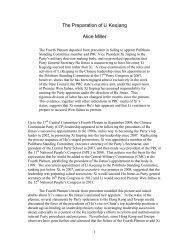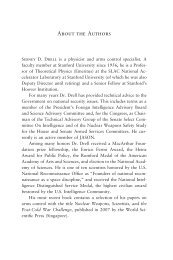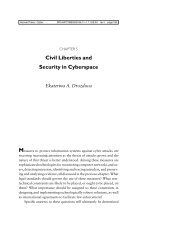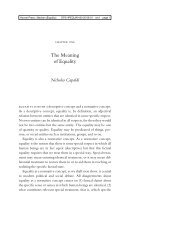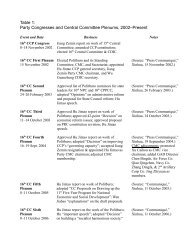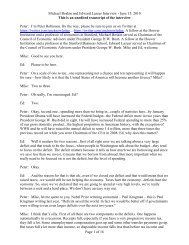Why Ritalin Rules - Hoover Institution
Why Ritalin Rules - Hoover Institution
Why Ritalin Rules - Hoover Institution
Create successful ePaper yourself
Turn your PDF publications into a flip-book with our unique Google optimized e-Paper software.
<strong>Why</strong> <strong>Ritalin</strong> <strong>Rules</strong> 255<br />
■ ■ ■ ■ ■ ■ ■ ■ ■ ■ ■ ■ ■ ■ ■ ■ ■ ■ ■ ■ ■ ■ ■ ■ ■ ■ ■ ■ ■ ■ ■ ■ ■ ■ ■ ■ ■ ■ ■ ■ ■ ■ ■ ■ ■ ■ ■ ■ ■ ■ ■ ■<br />
<strong>Why</strong> <strong>Ritalin</strong> <strong>Rules</strong><br />
Mary Eberstadt<br />
This selection first appeared in the April/May 1999 issue of Policy Review. Mary<br />
Eberstadt is consulting editor to Policy Review.<br />
There are stories that are mere signs of the Times, and then there are<br />
stories so emblematic of a particular time and place that they demand<br />
to be designated cultural landmarks. Such a story was the New York<br />
Times’s front-page report on January 18 appearing under the tame, even<br />
soporific headline, “For School Nurses, More Than Tending the Sick.”<br />
“<strong>Ritalin</strong>, <strong>Ritalin</strong>, seizure drugs, <strong>Ritalin</strong>,” in the words of its sing-song<br />
opening. “So goes the rhythm of noontime” for a typical school nurse in<br />
East Boston “as she trots her tray of brown plastic vials and paper water<br />
cups from class to class, dispensing pills into outstretched young palms.”<br />
For this nurse, as for her counterparts in middle- and upper-middle-class<br />
schools across the country, the day’s routine is now driven by what the<br />
Times dubs “a ticklish question,” to wit: “With the number of children<br />
across the country taking <strong>Ritalin</strong> estimated at well over three million,<br />
more than double the 1990 figure, who should be giving out the pills?”<br />
“With nurses often serving more than one school at a time,” the story<br />
goes on to explain, “the whole middle of the day can be taken up in a<br />
school-to-school scurry to dole out drugs.” Massachusetts, for its part,<br />
has taken to having the nurse deputize “anyone from a principal to a<br />
secretary” to share the burden. In Florida, where the ratio of school<br />
nurses to students is particularly low, “many schools have clerical workers<br />
hand out the pills.” So many pills, and so few professionals to go<br />
around. What else are the authorities to do?<br />
Behold the uniquely American psychotropic universe, pediatrics<br />
zone—a place where “psychiatric medications in general have become<br />
more common in schools” and where, in particular, “<strong>Ritalin</strong> dominates.”<br />
There are by now millions of stories in orbit here, and the particular one<br />
chosen by the Times—of how the drug has induced a professional labor<br />
shortage—is no doubt an estimable entry. But for the reader struck by<br />
some of the facts the Times mentions only in passing—for example, that<br />
<strong>Ritalin</strong> use more than doubled in the first half of the decade alone, that
256 Educationally Disadvantaged<br />
production has increased 700 percent since 1990, or that the number of<br />
schoolchildren taking the drug may now, by some estimates, be approaching<br />
the 4 million mark—mere anecdote will only explain so much.<br />
Fortunately, at least for the curious reader, there is a great deal of<br />
other material now on offer, for the explosion in <strong>Ritalin</strong> consumption<br />
has been very nearly matched by a publishing boom dedicated to that<br />
same phenomenon. Its harbingers include, for example, Barbara<br />
Ingersoll’s now-classic 1988 Your Hyperactive Child, among the first works<br />
to popularize a drug regimen for what we now call attention deficit disorder<br />
(ADD, called ADHD when it includes hyperactivity). Five years<br />
later, with ADD diagnoses and <strong>Ritalin</strong> prescriptions already rising<br />
steeply in the better-off neighborhoods and schools, Peter D. Kramer<br />
helped fuel the boom with his best-selling Listening to Prozac—a book<br />
that put the phrase “cosmetic pharmacology” into the vernacular and<br />
thereby inadvertently broke new conceptual ground for the advocates<br />
of <strong>Ritalin</strong>. In 1994, most important, psychiatrists Edward M. Hallowell<br />
and John J. Ratey published their own best-selling Driven to Distraction:<br />
Recognizing and Coping with Attention Deficit Disorder from Childhood to<br />
Adulthood, a book that was perhaps the single most powerful force in the<br />
subsequent proliferation of ADD diagnoses; as its opening sentence accurately<br />
prophesied, “Once you catch on to what this syndrome is all<br />
about, you’ll see it everywhere.”<br />
Not everyone received these soundings from the psychotropic beyond<br />
with the same enthusiasm. One noteworthy dissent came in 1995<br />
with Thomas Armstrong’s The Myth of the ADD Child, which attacked<br />
both the scientific claims made on behalf of ADD and what<br />
Armstrong decried as the “pathologizing” of normal children. Dissent<br />
also took the form of wary public pronouncements by the National<br />
Education Association (NEA), one of several groups to harbor the fear<br />
that ADD would be used to stigmatize minority children. Meanwhile,<br />
scare stories on the abuse and side effects of <strong>Ritalin</strong> popped out here<br />
and there in the mass media, and a national controversy was born.<br />
From the middle to the late 1990s, other interested parties from all<br />
over—the Drug Enforcement Administration (DEA), the Food and<br />
Drug Administration (FDA), the medical journals, the National<br />
Institutes of Health (NIH), and especially the extremely active advocacy<br />
group CHADD (Children and Adults with Attention Deficit<br />
Disorder)—further stoked the debate through countless reports, conferences,<br />
pamphlets, and exchanges on the Internet.
<strong>Why</strong> <strong>Ritalin</strong> <strong>Rules</strong> 257<br />
To this outpouring of information and opinion two new books, both<br />
on the critical side of the ledger, have just been added: Richard<br />
DeGrandpre’s iconoclastic <strong>Ritalin</strong> Nation: Rapid-Fire Culture and the Transformation<br />
of Human Consciousness (Simon & Schuster, 1999), and physician<br />
Lawrence H. Diller’s superbly analytical Running on <strong>Ritalin</strong>: A Physician<br />
Reflects on Children, Society and Performance in a Pill (Bantam Books, 1998).<br />
Their appearance marks an unusually opportune moment in which to<br />
sift through some ten years’ worth of information on <strong>Ritalin</strong> and ADD<br />
and to ask what, if anything, we have learned from the national experiment<br />
that has made both terms into household words.<br />
Let’s put the question bluntly: How has it come to pass that in fin-desiècle<br />
America, where every child from preschool onward can recite the<br />
“anti-drug” catechism by heart, millions of middle- and upper-middleclass<br />
children are being legally drugged with a substance so similar to<br />
cocaine that, as one journalist accurately summarized the science, “it<br />
takes a chemist to tell the difference”?<br />
What Is Methylphenidate?<br />
The first thing that has made the <strong>Ritalin</strong> explosion possible is that<br />
methylphenidate, to use the generic term, is perhaps the most widely<br />
misunderstood drug in America today. Despite the fact that it is, as<br />
Lawrence Diller observes in Running on <strong>Ritalin</strong>, “the most intensively<br />
studied drug in pediatrics,” most laymen remain under a misimpression<br />
both about the nature of the drug itself and about its pharmacological<br />
effects on children.<br />
What most people believe about this drug is the same erroneous<br />
characterization that appeared elsewhere in the Times piece quoted<br />
earlier—that it is “a mild stimulant of the central nervous system that,<br />
for reasons not fully understood, often helps children who are chronically<br />
distractible, impulsive and hyperactive settle down and concentrate.”<br />
The word “stimulant” here is at least medically accurate.<br />
“Mild,” a more ambiguous judgment, depends partly on the dosage,<br />
and partly on whether the reader can imagine describing as “mild” any<br />
dosage of the drugs to which methylphenidate is closely related. These<br />
include dextroamphetamine (street name: “dexies”), methamphetamine<br />
(street name: “crystal meth”), and, of course, cocaine. But the<br />
chief substance of the Times’s formulation here—that the reasons why<br />
<strong>Ritalin</strong> does what it does to children remain a medical mystery—is, as
258 Educationally Disadvantaged<br />
informed writers from all over the debate have long acknowledged, an<br />
enduring public myth.<br />
“Methylphenidate,” in the words of a 1995 DEA background paper<br />
on the drug, “is a central nervous system (CNS) stimulant and shares<br />
many of the pharmacological effects of amphetamine, methamphetamine,<br />
and cocaine.” Further, it “produces behavioral, psychological, subjective,<br />
and reinforcing effects similar to those of d-amphetamine<br />
including increases in rating of euphoria, drug liking and activity, and decreases<br />
in sedation.” To put the point conversely, as Richard DeGrandpre<br />
does in <strong>Ritalin</strong> Nation by quoting a 1995 report in the Archives of General<br />
Psychiatry, “Cocaine, which is one of the most reinforcing and addicting<br />
of the abused drugs, has pharmacological actions that are very similar to<br />
those of methylphenidate, which is now the most commonly prescribed<br />
psychotropic medicine for children in the U.S.”<br />
Such pharmacological similarities have been explored over the years<br />
in numerous studies. DeGrandpre reports that “lab animals given the<br />
choice to self-administer comparative doses of cocaine and <strong>Ritalin</strong> do<br />
not favor one over another” and that “a similar study showed monkeys<br />
would work in the same fashion for <strong>Ritalin</strong> as they would for cocaine.”<br />
The DEA reports another finding—that methylphenidate is actually<br />
“chosen over cocaine in preference studies” of non-human primates (emphasis<br />
added). In Driven to Distraction, pro-<strong>Ritalin</strong> psychiatrists Hallowell<br />
and Ratey underline the interchangeable nature of methylphenidate<br />
and cocaine when they observe that “people with ADD feel focused<br />
when they take cocaine, just as they do when they take <strong>Ritalin</strong> [emphasis<br />
added].” Moreover, methylphenidate (like other stimulants) appears to<br />
increase tolerance for related drugs. Recent evidence indicates, for example,<br />
that when people accustomed to prescribed <strong>Ritalin</strong> turn to cocaine,<br />
they seek higher doses of it than do others. To summarize, again<br />
from the DEA report, “it is clear that methylphenidate substitutes for cocaine<br />
and d-amphetamine in a number of behavioral paradigms.”<br />
All of which is to say that <strong>Ritalin</strong> “works” on children in the same<br />
way that related stimulants work on adults—sharpening the short-term<br />
attention span when the drug kicks in and producing equally predictable<br />
valleys (“coming down,” in the old street parlance; “rebounding,”<br />
in <strong>Ritalin</strong>ese) when the effect wears off. Just as predictably,<br />
children are subject to the same adverse effects as adults imbibing such<br />
drugs, with the two most common—appetite suppression and insomnia—<br />
being of particular concern. That is why, for example, handbooks on
<strong>Why</strong> <strong>Ritalin</strong> <strong>Rules</strong> 259<br />
ADD will counsel parents to see their doctor if they feel their child is<br />
losing too much weight, and why some children who take<br />
methylphenidate are also prescribed sedatives to help them sleep. It is<br />
also why one of the more Orwellian phrases in the psychotropic universe,<br />
“drug holidays”—meaning scheduled times, typically on weekends<br />
or school vacations, when the dosage of methylphenidate is<br />
lowered or the drug temporarily withdrawn in order to keep its adverse<br />
effects in check—is now so common in the literature that it no longer<br />
even appears in quotations.<br />
Just as, contrary to folklore, the adult and child physiologies respond<br />
in the same way to such drugs, so too do the physiologies of all people,<br />
regardless of whether they are diagnosed with ADD or hyperactivity. As<br />
Diller puts it, in a point echoed by many other sources, methylphenidate<br />
“potentially improves the performance of anyone–child or not, ADDdiagnosed<br />
or not.” Writing in the Public Interest last year, psychologist Ken<br />
Livingston provided a similar summary of the research, citing “studies<br />
conducted during the mid seventies to early eighties by Judith Rapaport<br />
of the National Institute of Mental Health” which “clearly showed that<br />
stimulant drugs improve the performance of most people, regardless of<br />
whether they have a diagnosis of ADHD, on tasks requiring good attention.”<br />
(“Indeed,” he comments further in an obvious comparison, “this<br />
probably explains the high levels of ‘self-medicating’ around the world”<br />
in the form of “stimulants like caffeine and nicotine.”)<br />
A third myth about methylphenidate is that it, alone among drugs of<br />
its kind, is immune to being abused. To the contrary: Abuse statistics<br />
have flourished alongside the boom in <strong>Ritalin</strong> prescription-writing.<br />
Though it is quite true that elementary schoolchildren are unlikely to<br />
ingest extra doses of the drug, which is presumably kept away from little<br />
hands, a very different pattern has emerged among teenagers and<br />
adults who have the manual dexterity to open prescription bottles and<br />
the wherewithal to chop up and snort their contents (a method that puts<br />
the drug into the bloodstream far faster than oral ingestion). For this<br />
group, statistics on the proliferating abuse of methylphenidate in<br />
schoolyards and on the street are dramatic.<br />
According to the DEA, for example, as early as 1994 <strong>Ritalin</strong> was the<br />
fastest-growing amphetamine being used “non-medically” by high school<br />
seniors in Texas. In 1991, reports DeGrandpre in <strong>Ritalin</strong> Nation, “children<br />
between the ages of 10 and 14 years old were involved in only about 25<br />
emergency room visits connected with <strong>Ritalin</strong> abuse. In 1995, just four
260 Educationally Disadvantaged<br />
years later, that number had climbed to more than 400 visits, which for<br />
this group was about the same number of visits as for cocaine.” Not surprisingly,<br />
given these and other measures of methylphenidate’s recreational<br />
appeal, criminal entrepreneurs have responded with interest to<br />
the drug’s increased circulation. From 1990 to 1995, the DEA reports,<br />
there were about 2,000 thefts of methylphenidate, most of them night<br />
break-ins at pharmacies—meaning that the drug “ranks in the top 10<br />
most frequently reported pharmaceutical drugs diverted from licensed<br />
handlers.”<br />
Because so many teenagers and college students have access to it,<br />
methylphenidate is particularly likely to be abused on school grounds.<br />
“The prescription drug <strong>Ritalin</strong>,” reported Newsweek in 1995, “is now a<br />
popular high on campus—with some serious side effects.” DeGrandpre<br />
notes that at his own college in Vermont, <strong>Ritalin</strong> was cited as the thirdfavorite<br />
drug to snort in a campus survey. He also runs, without comment,<br />
scores of individual abuse stories from newspapers across the country<br />
over several pages of his book. In Running on <strong>Ritalin</strong>, Diller cites several undercover<br />
narcotics agents who confirm that “<strong>Ritalin</strong> is cheaper and easier<br />
to purchase at playgrounds than on the street.” He further reports one<br />
particularly hazardous fact about <strong>Ritalin</strong> abuse, namely that teenagers,<br />
especially, do not consider the drug to be anywhere near as dangerous as<br />
heroin or cocaine. To the contrary: “they think that since their younger<br />
brother takes it under a doctor’s prescription, it must be safe.”<br />
In short, methylphenidate looks like an amphetamine, acts like an<br />
amphetamine, and is abused like an amphetamine. Perhaps not surprisingly,<br />
those who value its medicinal effects tend to explain the drug<br />
differently. To some, <strong>Ritalin</strong> is to children what Prozac and other psychotropic<br />
“mood brightening” drugs are to adults—a short-term fix for<br />
enhancing personality and performance. But the analogy is misleading.<br />
Prozac and its sisters are not stimulants with stimulant side effects; there<br />
is, ipso facto, no black market for drugs like these. Even more peculiar<br />
is the analogy favored by the advocates in CHADD: that “Just as a pair<br />
of glasses help the nearsighted person focus,” as Hallowell and Ratey<br />
explain, “so can medication help the person with ADD see the world<br />
more clearly.” But there is no black market for eyeglasses, either—nor<br />
loss of appetite, insomnia, “dysphoria” (an unexplained feeling of sadness<br />
that sometimes accompanies pediatric <strong>Ritalin</strong>-taking), nor even the<br />
faintest risk of toxic psychosis, to cite one of <strong>Ritalin</strong>’s rare but dramatically<br />
chilling possible effects.
<strong>Why</strong> <strong>Ritalin</strong> <strong>Rules</strong> 261<br />
What is methylphenidate “really” like? Thomas Armstrong, writing<br />
in The Myth of the ADD Child four years ago, probably summarized the<br />
drug’s appeal best. “Many middle- and upper-middle- class parents,”<br />
he observed then, “see <strong>Ritalin</strong> and related drugs almost as ‘cognitive<br />
steroids’ that can be used to help their kids focus on their schoolwork<br />
better than the next kid.” Put this way, the attraction to <strong>Ritalin</strong> makes<br />
considerable sense. In some ways, one can argue, that after-lunch hit of<br />
low-dose methylphenidate is much like the big cup from Starbucks that<br />
millions of adults swig to get them through the day—but only in some<br />
ways. There is no dramatic upswing in hospital emergency room visits<br />
and pharmacy break-ins due to caffeine abuse; the brain being jolted<br />
awake in one case is that of an adult, and in the other that of a developing<br />
child; and, of course, the substance doing the jolting on all those<br />
children is not legally available and ubiquitous caffeine, but a substance<br />
that the DEA insists on calling a Schedule II drug, meaning that it is<br />
subject to the same controls, and for the same reasons of abuse potential,<br />
as related stimulants and other powerful drugs like morphine.<br />
What Is CHADD?<br />
This mention of Schedule II drugs brings us to a second reason for the<br />
<strong>Ritalin</strong> explosion in this decade. That is the extraordinary political and<br />
medical clout of CHADD, by far the largest of the ADD support<br />
groups and a lobbying organization of demonstrated prowess. Founded<br />
in 1987, CHADD had, according to Diller, grown by 1993 to include<br />
35,000 families and 600 chapters nationally. Its professional advisory<br />
board, he notes, “includes most of the most prominent academicians in<br />
the ADD world, a veritable who’s who in research.”<br />
Like most support groups in self-help America, CHADD functions<br />
partly as clearing-house and information center for its burgeoning<br />
membership—organizing speaking events, issuing a monthly<br />
newsletter (CHADDerbox), putting out a glossy magazine (named, naturally<br />
enough, Attention! ), and operating an exceedingly active website<br />
stocked with on-line fact sheets and items for sale. Particular<br />
scrutiny is given to every legal and political development offering<br />
new benefits for those diagnosed with ADD. On these and other<br />
fronts of interest, CHADD leads the ADD world. “No matter how<br />
many sources of information are out there,” as a slogan on its website<br />
promises, “CHADD is the one you can trust.”
262 Educationally Disadvantaged<br />
One of CHADD’s particular strengths is that it is exquisitely mediasensitive,<br />
and has a track record of delivering speedy responses to any<br />
reports on <strong>Ritalin</strong> or ADD that the group deems inaccurate. Diller<br />
quotes as representative one fund-raising letter from 1997, where the<br />
organization listed its chief goals and objectives as “conduct[ing] a<br />
proactive media campaign” and “challeng[ing] negative, inaccurate reports<br />
that demean or undermine people with ADD.” Citing “savage attacks”<br />
in the Wall Street Journal and Forbes, the letter also went on to<br />
exhort readers into “fighting these battles of misinformation, innuendo,<br />
ignorance and outright hostility toward CHADD and adults who have<br />
a neurobiological disorder.” The circle-the-wagons rhetoric here appears<br />
to be typical of the group, as is the zeal.<br />
Certainly it was with missionary fervor that CHADD, in 1995,<br />
mounted an extraordinary campaign to make <strong>Ritalin</strong> easier to obtain.<br />
Methylphenidate, as mentioned, is a Schedule II drug. That means,<br />
among other things, that the DEA must approve an annual production<br />
quota for the substance—a fact that irritates those who rely on it, since<br />
it raises the specter, if only in theory, of a <strong>Ritalin</strong> “shortage.” It also<br />
means that some states require that prescriptions for <strong>Ritalin</strong> be written<br />
in triplicate for the purpose of monitoring its use, and that refills cannot<br />
simply be called into the pharmacy as they can for Schedule III<br />
drugs (for example, low-dosage opiates like Tylenol with codeine, and<br />
various compounds used to treat migraine). Doctors, particularly those<br />
who prescribe <strong>Ritalin</strong> in quantity, are inconvenienced by this requirement.<br />
So too are many parents, who dislike having to stop by the doctor’s<br />
office every time the <strong>Ritalin</strong> runs out. Moreover, many parents and<br />
doctors alike object to methylphenidate’s Schedule II classification in<br />
principle, on the grounds that it makes children feel stigmatized; the authors<br />
of Driven to Distraction, for example, claim that one of the most<br />
common problems in treating ADD is that “some pharmacists, in their<br />
attempt to comply with federal regulations, make consumers [of<br />
<strong>Ritalin</strong>] feel as though they are obtaining illicit drugs.”<br />
For all of these reasons, CHADD petitioned the DEA to reclassify<br />
<strong>Ritalin</strong> as a Schedule III drug. This petition was co-signed by the<br />
American Academy of Neurology, and it was also supported by other<br />
distinguished medical bodies, including the American Academy of<br />
Pediatrics, the American Psychological Association, and the American<br />
Academy of Child and Adolescent Psychiatry. Diller’s account of this<br />
episode in Running on <strong>Ritalin</strong> is particularly credible, for he is a doctor
<strong>Why</strong> <strong>Ritalin</strong> <strong>Rules</strong> 263<br />
who has himself written many prescriptions for <strong>Ritalin</strong> in cases where<br />
he has judged it to be indicated. Nevertheless, he found himself dissenting<br />
strongly from the effort to decontrol it—an effort that, as he<br />
writes, was “unprecedented in the history of Schedule II substances”<br />
and “could have had a profound impact on the availability of the drug.”<br />
What happened next, while CHADD awaited the DEA’s verdict, was<br />
in Diller’s words “a bombshell.” For before the DEA had officially responded,<br />
a television documentary revealed that Ciba-Geigy (now called<br />
Novartis), the pharmaceuticals giant that manufactures <strong>Ritalin</strong>, had<br />
contributed nearly $900,000 to CHADD over five years, and that<br />
CHADD had failed to disclose the contributions to all but a few selected<br />
members.<br />
The response from the DEA, which appeared in the background report<br />
cited earlier, was harsh and uncompromising. Backed by scores of<br />
footnotes and well over 100 sources in the medical literature, this report<br />
amounted to a public excoriation of CHADD’s efforts and a meticulous<br />
description, alarming for those who have read it, of the realities of <strong>Ritalin</strong><br />
use and abuse. “Most of the ADHD literature prepared for public consumption<br />
and available to parents,” the DEA charged, “does not address<br />
the abuse liability or actual abuse of methylphenidate. Instead,<br />
methylphenidate is routinely portrayed as a benign, mild stimulant that is<br />
not associated with abuse or serious effects. In reality, however, there is an<br />
abundance of scientific literature which indicates that methylphenidate<br />
shares the same abuse potential as other Schedule II stimulants.”<br />
The DEA went on to note its “concerns” over “the depth of the financial<br />
relationship between CHADD and Ciba-Geigy.” Ciba-Geigy,<br />
the DEA observed, “stands to benefit from a change in scheduling of<br />
methylphenidate.” It further observed that the United Nations<br />
International Narcotics Control Board (INCB) had “expressed concern<br />
about non-governmental organizations and parental associations in the<br />
United States that are actively lobbying for the medical use of<br />
methylphenidate for children with ADD.” (The rest of the world, it<br />
should be noted, has yet to acquire the American taste for <strong>Ritalin</strong>.<br />
Sweden, for example, had methylphenidate withdrawn from the market<br />
in 1968 following a spate of abuse cases. Today, 90 percent of<br />
<strong>Ritalin</strong> production is consumed in the United States.) The report concluded<br />
with the documented observations that “abuse data indicate a<br />
growing problem among school-age children,” that “ADHD adults<br />
have a high incidence of substance disorders,” and that “with three to
264 Educationally Disadvantaged<br />
five percent of today’s youth being administered methylphenidate on a<br />
chronic basis, these issues are of great concern.”<br />
Yet whatever public embarrassment CHADD and its supporters may<br />
have suffered on account of this setback turned out to be short-lived.<br />
Though it failed in the attempt to decontrol <strong>Ritalin</strong> (in the end, the<br />
group withdrew its petition), on other legislative fronts CHADD was<br />
garnering one victory after another. By the end of the 1990s, thanks<br />
largely to CHADD and its allies, an ADD diagnosis could lead to an impressive<br />
array of educational, financial, and social service benefits.<br />
In elementary and high school classrooms, a turning point came in<br />
1991 with a letter from the U.S. Department of Education to state school<br />
superintendents outlining “three ways in which children labeled ADD<br />
could qualify for special education services in public school under existing<br />
laws,” as Diller puts it. This directive was based on the landmark 1990<br />
Individuals with Disabilities Education Act (IDEA), which “mandates<br />
that eligible children receive access to special education and/or related<br />
services, and that this education be designed to meet each child’s unique<br />
educational needs” through an individualized program. As a result,<br />
ADD-diagnosed children are now entitled by law to a long list of services,<br />
including separate special-education classrooms, learning specialists, special<br />
equipment, tailored homework assignments, and more. The IDEA<br />
also means that public school districts unable to accommodate such children<br />
may be forced to pick up the tab for private education.<br />
In the field of higher education, where the first wave of <strong>Ritalin</strong>-taking<br />
students has recently landed, an ADD diagnosis can be parlayed into<br />
other sorts of special treatment. Diller reports that ADD-based requests<br />
for extra time on SATs, LSATs, and MCATs have risen sharply<br />
in the course of the 1990s. Yet the example of such high-profile tests<br />
is only one particularly measurable way of assessing ADD’s impact on<br />
education; in many classrooms, including college classrooms, similar<br />
“accommodations” are made informally at a student’s demand. A professor<br />
in the Ivy League tells me that students with an ADD diagnosis<br />
now come to him “waving doctor’s letters and pills” and requesting<br />
extra time for routine assignments. To refuse “accommodation” is to<br />
risk a hornet’s nest of liabilities, as a growing caseload shows. A 1996<br />
article in Forbes cites the example of Whittier Law School, which was<br />
sued by an ADD-diagnosed student for giving only 20 extra minutes<br />
per hour-long exam instead of a full hour. The school, fearing an expensive<br />
legal battle, settled the suit. It further undertook a preventive
<strong>Why</strong> <strong>Ritalin</strong> <strong>Rules</strong> 265<br />
measure: banning pop quizzes “because ADD students need separate<br />
rooms and extra time.”<br />
Concessions have also been won by advocates in the area of college<br />
athletics. The National College Athletic Association (NCAA) once<br />
prohibited <strong>Ritalin</strong> usage (as do the U.S. and International Olympic<br />
Committees today) because of what Diller calls its “possible acute<br />
performance-enhancing benefits.” In 1993, citing legal jeopardy as a<br />
reason for changing course, the NCAA capitulated. Today a letter<br />
from the team physician will suffice to allow an athlete to ingest<br />
<strong>Ritalin</strong>, even though that same athlete would be disqualified from<br />
participating in the Olympics if he were to test positive for stimulants.<br />
Nor are children and college students the only ones to claim benefits<br />
in the name of ADD. With adults now accounting for the fastestgrowing<br />
subset of ADD diagnoses, services and accommodations are<br />
also proliferating in the workplace. The enabling regulations here are<br />
1997 guidelines from the Equal Employment Opportunity Commission<br />
(EEOC) which linked traits like chronic lateness, poor judgment,<br />
and hostility to coworkers—in other words, the sorts of traits people<br />
get fired for—to “psychiatric impairments,” meaning traits that are<br />
protected under the law. As one management analyst for the Wall<br />
Street Journal recently observed (and as CHADD regularly reminds its<br />
readers), these EEOC guidelines have already generated a list of accommodations<br />
for ADD-diagnosed employees, including special office<br />
furniture, special equipment such as tape recorders and laptops,<br />
and byzantine organizational schemes (color coding, buddy systems,<br />
alarm clocks, and other “reminders”) designed to keep such employees<br />
on track. “Employers,” this writer warned, “could find themselves<br />
facing civil suits and forced to restore the discharged people to their<br />
old positions, or even give them promotions as well as back pay or reasonable<br />
accommodation.”<br />
An ADD diagnosis can also be helpful in acquiring Supplemental<br />
Security Income (SSI) benefits. SSI takes income into account in providing<br />
benefits to the ADD-diagnosed; in that, it is an exception to the<br />
trend. Most of the benefits now available, as even this brief review indicates,<br />
have come to be provided in principle, on account of the diagnosis<br />
per se. Seen this way, and taking the class composition of the<br />
ADD-diagnosed into account, it is no wonder that more and more people,<br />
as Diller and many other doctors report, are now marching into<br />
medical offices demanding a letter, a diagnosis, and a prescription. The
266 Educationally Disadvantaged<br />
pharmacological charms of <strong>Ritalin</strong> quite apart, ADD can operate, in<br />
effect, as affirmative action for affluent white people.<br />
What Is Attention Deficit Disorder?<br />
Another factor that has put <strong>Ritalin</strong> into millions of medicine cabinets has<br />
to do with the protean nature of the disorder for which it is prescribed—<br />
a disorder that was officially so designated by the American Psychiatric<br />
Association in 1980, and one that, to cite Thomas Armstrong, “has gone<br />
through at least 25 different name changes in the past century.”<br />
Despite the successful efforts to have ADD construed as a disability<br />
like blindness, the question of what ADD is remains passionately disputed.<br />
To CHADD, of course, it is a “neurobiological disorder,” and<br />
not only to CHADD; “the belief that ADD is a neurological disease,”<br />
as Diller writes, also “prevails today among medical researchers and<br />
university teaching faculty” and “is reflected in the leading journals of<br />
psychiatry.” What the critics observe is something else—that “despite<br />
highly successful efforts to define ADD as a well-established disorder of<br />
the brain,” as DeGrandpre puts it in a formulation echoed by many,<br />
“three decades of medical science have yet to produce any substantive<br />
evidence to support such a claim.”<br />
Nonetheless, the effort to produce such evidence has been prodigious.<br />
Research on the neurological side of ADD has come to resemble<br />
a Holy Grail-like quest for something, anything, that can be said to set<br />
the ADD brain apart—genes, imbalances of brain chemicals like<br />
dopamine and serotonin, neurological damage, lead poisoning, thyroid<br />
problems, and more. The most famous of these studies, and the chief<br />
grounds on which ADD has come to be categorized as a neurobiological<br />
disability, was reported in The New England Journal of Medicine in 1990<br />
by Alan Zametkin and colleagues at the National Institute of Mental<br />
Health (NIMH). These researchers used then-new positron emission tomography<br />
(PET) scanning to measure differences in glucose metabolizing<br />
between hyperactive adults and a control group. According to the<br />
study’s results, what emerged was a statistically significant difference in<br />
the rates of glucose metabolism—a difference hailed by many observers<br />
as the first medical “proof ” of a biological basis for ADD.<br />
Diller and DeGrandpre are only the latest to argue, at length, that the<br />
Zametkin study established no such thing. For starters—and from the<br />
scientific point of view, most important—a series of follow-up studies, as
<strong>Why</strong> <strong>Ritalin</strong> <strong>Rules</strong> 267<br />
Diller documents, “failed to confirm” the original result. DeGrandpre,<br />
for his part, details the methodological problems with the study itself—<br />
that the participants were adults rather than children, meaning that the<br />
implications for the majority of the <strong>Ritalin</strong>-taking population were unclear<br />
at best; that there was “no evidence” that the reported difference<br />
in metabolism bore any relationship to behavioral activity; that the study<br />
was further plagued by “a confounding variable that had nothing to do<br />
with ADD,” namely that the control group included far fewer male subjects<br />
than the ADD group; and that, even if there had been a valid difference<br />
in metabolism between the two groups, “this study tells us<br />
nothing about the cause of these differences.”<br />
Numerous other attempts to locate the missing link between ADD and<br />
brain activity are likewise dissected by Diller and DeGrandpre in their<br />
books. So too is the causal fallacy prevalent in ADD literature—that if a<br />
child responds positively to <strong>Ritalin</strong>, that response “proves” that he has an<br />
underlying biological disorder. This piece of illogic is easily dismissed. As<br />
these and other authors emphasize, drugs like <strong>Ritalin</strong> have the same effect<br />
on just about everybody. Give it to almost any child, and the child will become<br />
more focused and less aggressive—one might say, easier to manage—<br />
whether or not there were “symptoms” of ADD in the first place.<br />
In sum, and as Thomas Armstrong noted four years ago in The Myth<br />
of the ADD Child, ADD remains an elusive disorder that “cannot be authoritatively<br />
identified in the same way as polio, heart disease, or other legitimate<br />
illnesses.” Instead, doctors depend on a series of tests designed<br />
to measure the panoply of ADD symptoms. To cite Armstrong again:<br />
“there is no prime mover in this chain of tests; no First Test for ADD that<br />
has been declared self-referential and infallible.” Some researchers, for<br />
example, use “continuous performance tasks” (CPTS) that require the<br />
person being tested to pay attention throughout a series of repetitive actions.<br />
A popular CPT is the Gordon Diagnostic System, a box that flashes<br />
numbers, whose lever is supposed to be pressed every time a particular<br />
combination appears. Yet as numerous critics have suggested, although<br />
the score that results is supposed to tell us about a given child’s ability to<br />
attend, its actual significance is rather ambiguous; perhaps, as Armstrong<br />
analyzes, “it only tells how a child will perform when attending to a repetitive<br />
series of meaningless numbers on a soulless task.”<br />
In the absence of any positive medical or scientific test, the diagnosis<br />
of ADD in both children and adults depends, today as a decade ago,<br />
almost exclusively on behavioral criteria. The diagnostic criteria for
268 Educationally Disadvantaged<br />
children, according to the latest Diagnostic and Statistics Manual<br />
(DSM-IV), include six or more months’ worth of some 14 activities<br />
such as fidgeting, squirming, distraction by extraneous stimuli, difficulty<br />
waiting turns, blurting out answers, losing things, interrupting, ignoring<br />
adults, and so on. (To read the list is to understand why boys are diagnosed<br />
with ADD three to five times as often as girls.) The diagnostic latitude<br />
offered by this list is obvious; as Diller understates the point,<br />
“what often strikes those encountering DSM criteria for the first time is<br />
how common these symptoms are among children” generally.<br />
The DSM criteria for adults are if anything even more expansive, and<br />
include such ambiguous phenomena as a sense of underachievement,<br />
difficulty getting organized, chronic procrastination, a search for high<br />
stimulation, impatience, impulsivity, and mood swings. Hallowell and<br />
Ratey’s 100-question test for ADD in Driven to Distraction, an elaborately<br />
extrapolated version of the DSM checklist, illustrates this profound elasticity.<br />
Their questions range from the straightforward (“Are you impulsive?”“Are<br />
you easily distracted?”“Do you fidget a lot?”) to more elusive<br />
ways of eliciting the disorder (“Do you change the radio station in your<br />
car frequently?” “Are you always on the go, even when you don’t really<br />
want to be?” “Do you have a hard time reading a book all the way<br />
through?”). Throughout, the distinction between what is pathological<br />
and what is not remains unclear—because, in the authors’ words, “There<br />
is no clear line of demarcation between ADD and normal behavior.”<br />
Thus the business of diagnosing ADD remains, as Diller puts it, “very<br />
much in the eye of the beholder.” In 1998, partly for that reason, the<br />
National Institutes of Health convened a conference on ADD with hundreds<br />
of participants and a panel of 13 doctors and educators. This conference,<br />
as newspapers reported at the time, broke no new ground, and<br />
indeed could not reach agreement on several important points—for instance,<br />
how long children should take drugs for ADD, or whether and<br />
when drug treatment might become risky. Even more interesting, conference<br />
members could not agree on what is arguably the rather fundamental<br />
question of how to diagnose the disorder in the first place. As one<br />
panelist, a pediatrician, put it succinctly, “The diagnosis is a mess.”<br />
Who Has ADD?<br />
To test this hypothesis, I gave copies of Hallowell and Ratey’s questionnaire<br />
to 20 people (let’s call them subjects) and asked them to com-
<strong>Why</strong> <strong>Ritalin</strong> <strong>Rules</strong> 269<br />
plete it and total up the number of times they checked “yes.” “These<br />
questions,” as Hallowell and Ratey note, “reflect those an experienced<br />
diagnostician would ask.” Although, as they observe, “this quiz cannot<br />
confirm the diagnosis” (as we have seen already, nothing can), it does<br />
“offer a rough assessment as to whether professional help should be<br />
sought.” In short, “the more questions that are answered ‘yes,’ the more<br />
likely it is that ADD may be present.”<br />
In a stab at methodological soundness, I had equal numbers of<br />
males and females take the test. All would be dubbed middle or upper<br />
middle class, all but one are or have been professionals of one sort or<br />
another, all are white, and the group was politically diverse—which is<br />
to say, the sample accurately reflects the socioeconomic pool from<br />
which most of the current <strong>Ritalin</strong>-taking population is drawn. As to<br />
the matter of observer interference, although some subjects may have<br />
guessed what the questionnaire was looking for, all of them (myself excepted,<br />
of course) took the test “blind,” that is, without any accompanying<br />
material to prejudice their responses.<br />
We begin with results at the lower end of the scale. Of the 18 subjects<br />
who completed the test, two delivered “yes” scores of 8 and 10 (a<br />
professor of English and his wife, an at-home mother active in philanthropy).<br />
These “yes” results, as it turned out, were at least threefold<br />
lower than anyone else’s. In “real” social science, according to some expert<br />
sources, we would simply call these low scores “outliers” and throw<br />
them out for the same reason. We, however, shall include them, if only<br />
on the amateur grounds of scrupulousness.<br />
The next lowest “yes” tallies—29 in each case—were achieved by<br />
an editorial assistant and a school nurse. That is to say, even these “low<br />
scorers” managed to answer yes almost a third of the time (remember, “the<br />
more questions that are answered ‘yes,’ the more likely it is that ADD<br />
may be present”). After them, we find a single “yes” score of 33 (an assistant<br />
editor). Following that, fully six subjects, or a third of the testfinishers,<br />
produced scores in the 40s. These include this magazine’s<br />
editor, two at-home mothers (one a graphic designer, the other a poet),<br />
a writer for Time and other distinguished publications, Policy Review’s<br />
business manager, and—scoring an estimable 49—the headmaster of<br />
a private school in Washington.<br />
Proceeding into the upper echelons, a novelist who is also an at-home<br />
mother reported her score as 55, and a renowned demographic expert with<br />
ties to Harvard and Washington think tanks scored a 57. A male British
270 Educationally Disadvantaged<br />
journalist and at-home father achieved a 60, and a female American journalist<br />
and at-home mother (me) got a 62. Still another at-home mother, this<br />
one with a former career in public relations, garnered a 65.<br />
In the lead, at least of the test-finishers, was a best-selling satirist<br />
whom we shall call, for purposes of anonymity, Patrick O’Rourke; he<br />
produced an estimable score of 75. “Mr. O’Rourke” further advanced<br />
the cause of science by answering the questions on behalf of his 16month-old<br />
daughter; according to his proud report, 65 was the result.<br />
Then there were the two subjects who, for whatever reason, were unable<br />
to complete the test in the first place. One of these subjects called<br />
to say that he’d failed to finish the test because he’d “gotten bored<br />
checking off so many yes answers.” When I pressed him for some, any,<br />
final tally for me to include, he got irritated and refused, saying he was<br />
“too lazy” to count them up. Finally he said “50 would be about right,”<br />
take it or leave it. He is a Wall Street investment banker specializing in<br />
the creation of derivative securities. Our last subject, perhaps the most<br />
pathological of all, failed to deliver any score despite repeated reminding<br />
phone calls from the research team. He is the professor mentioned<br />
earlier, the one who reported that ADD is now being used as a blanket<br />
for procrastination and shirking on campus.<br />
Now on to interpreting the results. Apart from the exceedingly anomalous<br />
two scores of ten and under, all the rest of the subjects reported<br />
answering “yes” to at least a quarter of the questions—surely enough to<br />
trigger the possibility of an ADD diagnosis, at least in those medical offices<br />
Diller dubs “<strong>Ritalin</strong> mills.” (As for the one subject who reported no<br />
result whatsoever, he is obviously entitled to untold ADD bonus points<br />
for that reason alone.) Fully 15 of the finishers, or 80-plus percent, answered<br />
yes to one-third of the questions or more. Eight of the finishers,<br />
or 40-plus percent of the sample, answered yes more than half of the<br />
time, with a number of scores in the high 40s right behind them. In<br />
other words, roughly half of the sample answered yes roughly half of the time.<br />
My favorite comment on the exercise came from the school nurse<br />
(who scored, one recalls, a relatively low 29). She has a background in psychiatry,<br />
and therefore realized what kind of diagnosis the questionnaire<br />
was designed to elicit. When she called to report her result, she said that<br />
taking the test had made her think hard about the whole ADD issue.<br />
“My goodness,” she concluded, “it looks like the kind of thing almost<br />
anybody could have.” This brings us to the fourth reason for the explosion<br />
of ADD and its prescribed corollary, <strong>Ritalin</strong>: The nurse is right.
<strong>Why</strong> <strong>Ritalin</strong> <strong>Rules</strong> 271<br />
What Is Childhood?<br />
The fourth and most obvious reason millions of Americans, most of<br />
them children, are now taking <strong>Ritalin</strong> can be summarized in a single<br />
word that crops up everywhere in the dry-bones literature on ADD and<br />
its drug of choice: compliance. One day at a time, the drug continues to<br />
make children do what their parents and teachers either will not or cannot<br />
get them to do without it: Sit down, shut up, keep still, pay attention.<br />
That some children are born with or develop behavioral problems<br />
so severe that drugs like <strong>Ritalin</strong> are a godsend is true and sad. It is also<br />
irrelevant to the explosion in psychostimulant prescriptions. For most,<br />
the drug is serving a more nuanced purpose—that of “help[ing] your<br />
child to be more agreeable and less argumentative,” as Barbara<br />
Ingersoll put it over a decade ago in Your Hyperactive Child.<br />
There are, as was mentioned, millions of stories in the <strong>Ritalin</strong> universe,<br />
and the literature of advocates and critics alike all illustrates this<br />
point. There is no denying that millions of people benefit from having<br />
children take <strong>Ritalin</strong>—the many, many parents who will attest that the<br />
drug has improved their child’s school performance, their home lives,<br />
often even their own marriages; the teachers who have been relieved by<br />
its effects in their classrooms, and have gone on to proselytize other parents<br />
of other unruly children (frequently, it is teachers who first suggest<br />
that a child be checked for the disorder); and the doctors who, when<br />
faced with all these grateful parents and teachers, find, as Diller finds,<br />
that “at times the pressure for me to medicate a child is intense.”<br />
Some other stories seep through the literature too, but only if one<br />
goes looking for them. These are the stories standing behind the clinical<br />
accounts of teenagers who lie and say they’ve taken the day’s dose<br />
when they haven’t, or of the children who cry in doctor’s offices and<br />
“cheek” the pill (hide it rather than swallow, another linguistic innovation<br />
of <strong>Ritalin</strong>ese) at home. These are the stories standing behind such<br />
statements as the following, culled from case studies throughout the literature:<br />
“It takes over of me [sic]; it takes control.” “It numbed me.”<br />
“Taking it meant I was dumb.” “I feel rotten about taking pills; why<br />
me?”“It makes me feel like a baby.” And, perhaps most evocative of all,<br />
“I don’t know how to explain. I just don’t want to take it any more.”<br />
But these quotes, as any reader will recognize, appeal only to sentiment;<br />
science, for its part, has long since declared its loyalties. In the end,<br />
what has made the <strong>Ritalin</strong> outbreak not only possible but inevitable is
272 Educationally Disadvantaged<br />
the ongoing blessing of the American medical establishment–and not<br />
only that establishment. In a particularly enthusiastic account of the<br />
drug in a recent issue of The New Yorker, writer Malcolm Gladwell exults<br />
in the idea that “we are now extending to the young cognitive aids of a<br />
kind that used to be reserved exclusively for the old.” He further suggests<br />
that, given expert estimates of the prevalence of ADD (up to 10 percent<br />
of the population, depending on the expert), if anything “too few” children<br />
are taking the drug. Surely all these experts have a point. Surely this<br />
country can do more, much more, to reduce fidgeting, squirming, talking<br />
excessively, interrupting, losing things, ignoring adults, and all those<br />
other pathologies of what used to be called childhood.<br />
■ ■ ■ ■ ■ ■ ■ ■ ■ ■ ■ ■ ■ ■ ■ ■ ■ ■ ■ ■ ■ ■ ■ ■ ■ ■ ■ ■ ■ ■ ■ ■ ■ ■ ■ ■ ■ ■ ■ ■ ■ ■ ■ ■ ■ ■ ■ ■ ■ ■ ■ ■<br />
The Scandal of Special Ed<br />
Robert Worth<br />
This selection first appeared in The Washington Monthly’s June 1999 issue. Robert<br />
Worth is a contributing editor to The Washington Monthly.<br />
If you’ve ever wondered what the words “special education” mean, consider<br />
Saundra Lemons. A tall, gangly 19-year-old senior in a<br />
Washington, D.C., public high school, she is quiet and attentive. Like the<br />
vast majority of children in special ed, she’s not blind or deaf or confined<br />
to a wheelchair; instead she has had trouble learning to read. If<br />
dollars were education, Saundra would be in fine shape. D.C. pours almost<br />
a third of its total education budget into the 10 percent of its students<br />
who are special ed. In theory—or rather, in wealthy school<br />
districts—this money buys kids like Saundra all kinds of assistance: special<br />
tutoring sessions, a modified curriculum, specially trained therapists<br />
and consultants, even untimed tests.<br />
But Saundra wasn’t born in a wealthy suburb. So when she started<br />
having trouble in first grade, she was placed—like many kids in D.C.—<br />
into a dead-end classroom where she learned nothing. In her case, it was<br />
a class for the mentally retarded. It took six years for a teacher to notice



